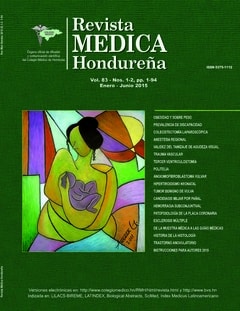Regional anesthesia: complicated cases and associated factors, Hospital Escuela Universitario, Tegucigalpa, Honduras, 2012-2013
Keywords:
Anesthesia, Epidural anesthesia, Regional anesthesia, Spinal anesthesiaAbstract
Background: Regional anesthesia techniques usage has increased in the past years; therefore, it is necessary to understand their complications. Objective: To describe the characteristics of the patients undergoing regional anesthesia and factors associated to complications, Hospital Escuela Universitario, Tegucigalpa, January 2012-January 2013. Methods: Case control study. Case: patient with elective or emergency surgical procedure undergoing regional anesthesia whom presented any anesthesia complication; Control: same that case that did not present complications, paired to cases by age +1 year. The sample was estimated in 150 cases and 150 controls. Clinical and epidemiological information was obtained from randomly selected medical records. OR and 95%CI were estimated; and statistical significance was considered when p<0.05. Results: Both groups presented similar age and weight distribution. ASA classification I and elective procedure were present in 50.6% (76) and 46.0% (69) of cases, and 58.6% (88) and 54.6% (82) controls, respectively. Spinal block was the most used, 76 (50.6%) and 106 (70.6%) cases and controls, respectively. The complications included failed blockade (75.0%), hypotension (24.6%) and bradycardia (10.0%). The spinal block and the absence of co-morbidities were identified as protector factors; ASA classification III-IV and co-morbidities were risk factors; hypertension and diabetes mellitus were associated 4 and 7 times more, respectively, to complicated cases; p<0.05. Discussion: Type of procedure elective or emergency was not associated to complications. It is recommended to stabilize patients who will undergo regional anesthesia, especially those with risk factors. It is necessary to identify factors related to failed blockade and implement corrective actions.
Downloads
199




